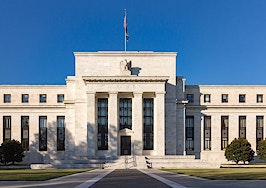No one can predict the future of real estate, but you can prepare. Find out what to prepare for and pick up the tools you’ll need at Virtual Inman Connect on Nov. 1-2, 2023. And don’t miss Inman Connect New York on Jan. 23-25, 2024, where AI, capital and more will be center stage. Bet big on the future and join us at Connect.
After kicking off the week by urging Federal Reserve policymakers to pledge an end to interest rates hikes, real estate trade groups have come up with another, slightly wonkier, proposal to bring mortgage rates down: Stop letting $35 billion in maturing mortgage-backed securities roll off the Fed’s books each month.
The latest idea — put forward Thursday by the National Association of Realtors and two trade groups representing lenders — is that if the Fed would just maintain its current mortgage holdings, that would reduce the abnormally wide “spread” between 10-year Treasury yields and mortgage rates.
The groups also want the Treasury Department to allow Fannie Mae and Freddie Mac to be granted a temporary waiver to purchase their own mortgage-backed securities (MBS), and FHA and VA mortgages securitized by Ginnie Mae.
Taken together, those actions could bring rates down by 1 to 1.5 percentage points, Independent Community Bankers of America CEO Rebeca Romero said.

Rebeca Romero
“With housing accounting for nearly 20 percent of the nation’s gross domestic product and affecting homeowners and renters nationwide, policymakers must act to promote housing affordability,” Romero said in a statement.
The groups, which also include the Community Home Lenders of America (CHLA), said in a letter that they “agree that taming inflation is a high priority and appreciate the Federal Reserve’s decisive and effective action to staunch inflation, even as that effort has resulted in short-term rates at 22-year highs.”
But the sluggish pace of home construction over the past decade has left the housing market with a structural shortage of 5 million housing units, the groups wrote the White House and Treasury Department (Fed Chair Jerome Powell and Sandra Thompson, who runs Fannie and Freddie’s regulator, the Federal Housing Finance Agency, were Cc’d).
“Our groups thoroughly respect the independence of the Federal Reserve but believe it should take this structural issue into consideration when evaluating strategies to attain the Fed’s desired 2.0 percent inflation target,” the letter states. “While federal regulators do not have direct influence on many local construction issues, they can affect affordability for homebuyers and homeowners through the 30-10 spread.”
The Federal Reserve had no comment on similar pleas Monday from real estate industry trade groups who urged Fed policymakers to promise that they’re not only done hiking rates, but to make clear that they have no plans to sell trillions of MBS the central bank bought during the pandemic.
In that effort, NAR teamed up with the Mortgage Bankers Association (MBA) and the National Association of Home Builders on a letter that put into writing concerns vocalized by MBA CEO Bob Broeksmit on CNBC last week.
In addition to urging the Fed to signal that it “does not contemplate further rate hikes,” the industry trade groups asked the Fed to make it clear to bond market investors that it “will not sell off any of its MBS holdings until and unless the housing finance market has stabilized, and mortgage-to-Treasury spreads have normalized.”
Rather than selling those assets, so far Fed has just been letting maturing assets roll of its books — up to $60 billion in Treasurys and $35 billion in MBS each month. But simply by allowing those passive roll offs, the Fed has trimmed more than $1 trillion in assets from its balance sheet, including more than $260 billion in MBS.
To meet the latest demand from industry groups and maintain its MBS holdings at current levels, the Fed would have to replace all of its maturing MBS each month.
Fed has trimmed $1 trillion from balance sheet
Source: Board of Governors of the Federal Reserve System, Federal Reserve Bank of St. Louis
At issue are the massive purchases of long-term Treasurys and MBS that the Fed undertook during the pandemic to keep interest rates low and keep the economy from imploding. In one week alone during March, 2020, the Fed bought $183.3 billion in MBS.
“Quantitative easing” continued until early last year, adding $80 billion in long-term Treasurys and $40 billion in MBS to the Fed’s balance sheet every month during much of the pandemic.
Now that Fed policymakers are struggling to rein in inflation, the central bank is trimming its massive holdings of government bonds and MBS, which peaked at $8.5 trillion. Although the Fed doesn’t have direct control over long-term rates, this “quantitative tightening” has helped push bond yields and mortgage rates up.
Wider primary mortgage spread

At 2.94 percentage points as of Oct. 11, the primary mortgage spread was 95 basis points above the pre-pandemic average of 1.99 percent. Source: Optimal Blue and Federal Reserve data retrieved from FRED, Federal Reserve Bank of St. Louis.
But mortgage rates have risen even more sharply than long-term bond yields. In the past, 10-year Treasury yields have been a good barometer of where mortgage rates are headed next, since investors see 10-year Treasurys and MBS as similar assets. But in recent years, there’s been a widening gap between Treasury yields and mortgage rates.
During the three years preceding the pandemic, the primary mortgage spread (or “30-10 spread” — the difference between rates on 30-year fixed rate mortgages and 10-year Treasurys) averaged 2 percentage points. So far this year, it’s averaged 2.88 percentage points, blipping over 3 percentage points on occasion.
Industry trade groups say that over the longer term, the historic norm for the spread has been roughly 150 basis points, or 1.5 percentage points. That’s the basis for their claim that returning the spread to its historic norm would bring mortgage rates down by 1 to 1.5 percentage points — even if 10-year Treasury yields didn’t budge from where they are today.
One factor driving the growing primary mortgage spread is the elevated prepayment risk currently faced by MBS investors. Many homeowners who take out a mortgage today are almost certain to refinance them if mortgage rates come down significantly. But when long-term Treasury yields do come down, the spread could shrink as prepayment risk diminishes, according to a recent analysis by the Urban Institute’s Laurie Goodman and Michael Neal.
On the bright side, that means that if long-term Treasury yields start to come down next year on expectations that the Fed is done raising short-term rates, mortgage rates may fall even faster. But housing industry trade groups want policymakers to do something about the “30-10 spread” now.
“For some 40 years, the Federal Reserve and Fannie Mae and Freddie Mac have acted as buyers of last resort for MBS to stabilize mortgage rates at times and ways that are appropriate,” the groups said Thursday. “U.S. banks, foreign central banks, overseas banks, and insurance companies have recently moved away from buying MBS … We believe this is an appropriate time for the Federal Reserve or Fannie and Freddie to step in and address this secular decline in demand for MBS.”
Given that Fed officials like to telegraph their intentions far in advance — and reaffirmed in September their intention to continue trimming $35 billion in MBS from the central banks’ balance sheet each month — industry groups aren’t expected to get quick action from the Fed on their demands.
And in April, Fannie and Freddie’s regulator followed through with risk-based fee increases that were strongly opposed by real estate industry groups, with FHFA Director Sandra Thompson saying they were needed to ensure the mortgage giants’ safety and soundness.
In order for Fannie and Freddie to buy their own MBS, the Treasury Department would have to agree to amend their senior Preferred Stock Purchase Agreements (PSPAs). The PSPAs outlined the terms of support provided by the government when the mortgage giants were placed in conservatorship in 2008 — in part due to losses on subprime MBS they purchased during the housing boom to meet affordable housing goals.
While the agreements have been amended before — including to allow Fannie and Freddie to build their capital reserves — permitting them to buy their own MBS could be a hard sell.
Housing and lending industry trade groups say they advocate amending the PSPA agreements “on a temporary basis” to enable Fannie and Freddie to purchase their own MBS, and Ginnie Mae MBS, “for a defined period of time.”
Get Inman’s Mortgage Brief Newsletter delivered right to your inbox. A weekly roundup of all the biggest news in the world of mortgages and closings delivered every Wednesday. Click here to subscribe.













